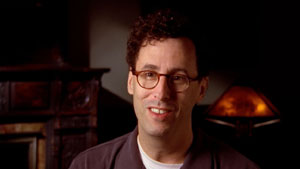|
Eugene O’Neill – A Documentary Film.
Directed by Ric Burns. Written by Arthur & Barbara Gelb
and Ric Burns. PBS, March 27, 2006 (American
Experience/WGBH – 9:00PM).
Anyone can make a documentary. It’s
become quite formulaic. You start with a story you want to tell, have a
narrator anchor your tale, illustrate with moving images or still images
over which you move, layer music and sound effects to create a mood, and add
a healthy dose of “talking heads” to gain intimacy and credibility.
Put together Muhammad Ali, Lloyd Price, Zaire, “Rumble in the Jungle,” and
George Plimpton, and you get Leon Gast’s ninety-minute “When We Were Kings.”
Put together Babe Ruth, Billy Crystal, Ebbets Field, “Take Me Out to the
Ballgame,” and Bob Costas, and you get Ken Burns’ eighteen-and-a-half-hour
“Baseball.”
Anyone could have made a documentary on Eugene O’Neill. Of course it helps
to have a big brother, who plucks you from the Columbia University campus to
help him fight nine episodes of “The Civil War.” It helps to have already
made a highly acclaimed documentary of your own on the Big Apple. It helps
to have enlisted the venerable Arthur and Barbara Gelb, who know more about
your subject than you can ever hope to know. It helps to have a bit of luck
– to have your hand slapped by a PBS executive for stretching a two hour
documentary into three, and then being told that your next project on Eugene
O’Neill, which you had planned on running four hours, WILL come in at two –
or more precisely, 112 minutes. And it helps to be a genius.
On Monday evening, January 23rd, some 150 invited guests filled the MGM
Screening Room at 6th Avenue and 55th Street in New York City. They
previewed the American Experience PBS documentary “Eugene O’Neill,” which
will premier on Monday, March 27, 2006. They previewed the genius of Ric
Burns.
“What does it cost to be an artist? What did it cost to be Eugene O’Neill?”
director Lloyd Richards asks in the opening moments of the film. “It cost
Eugene O’Neill a mother, a father, a happy marriage, children. It cost the
many wives that he tried to have because he didn’t know how.”
Burns uses Richards and his other “talking heads” to seamlessly tell his
story. “When I interview them, I sit across from them and look them in the
eye,” Burns related at his Steeplechase office, several days after the
screening. “If you don’t look them in the eye, they lose interest, and
you’ve lost them.”

Playwright
Tony Kushner |
Burns didn’t lose playwright Tony
Kushner, who movingly remarks in the film, "In O'Neill, there's this
absolute, sort of God-ordained mission, which is to keep searching, even if
in the process he discovers that there is no God. It's a terrifying sort of
mandate, but it also I think should be the mandate of all artists, and in a
way, of all people." Narrator Christopher Plummer provides the anchor for
playwrights Kushner and John Guare, directors Richards, Sidney Lumet and
Robert Brustein, and O’Neill scholars Edward Shaughnessy and the Gelbs. They
all respond to Burns’ deft technique, and are transformed from “talking
heads” into eloquent orators. Burns uses these heads to speak words about
O’Neill. He uses a second set of heads to speak O’Neill’s words. Al Pacino,
Zoe Caldwell, Christopher Plummer, Robert Sean Leonard, and others
strategically speak dialogue from O’Neill’s plays. They “speak” O’Neill’s
words, as opposed to performing them, and tell Burns’ story in much the same
way that the playwrights and the directors and the scholars tell it. It’s a
brilliant juxtaposition that helps Burns keep his story moving at a
cohesive, break-neck pace.
Burns starts his story in 1937, when O’Neill moves into Tao House, his
California hillside home. Burns uses this point in time as a fulcrum to look
backward and relate O’Neill’s break with his family, and then look forward,
as O’Neill reclaims his family and, as his reputation declines and illness
threatens to silence him forever, wrenches from himself three of the
greatest plays ever written by an American.
Burns’ story could have been told over four hours, or even
eighteen-and-a-half. The Gelbs would have had no problem providing the
necessary substrate. But that hand-slapping PBS executive fortuitously
forced them to cut and cut and cut their story to 112 minutes. Integrated
with Brian Keane’s magical score, a perfectly accessible tale was crafted
that can be easily consumed in one sitting.
The 150 invited guests in the MGM Screening Room already knew most, if not
all of Burns’ story. It wasn’t necessary to give the likes of Ted Mann and
Ben Brantley a history lesson on O’Neill. Had Burns’ documentary served only
to educate, it would have been just another formulaic example of its genre.
But, it did much more than educate. It forced those gathered on January 23rd
to feel what it cost to be an artist, and it forced many of them to shed a
tear for O’Neill and for others they had known who
had paid that price. Those assembled felt the tragedy and the genius of
Eugene O’Neill. And they felt the genius of Ric Burns.
|

